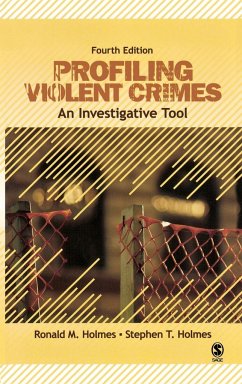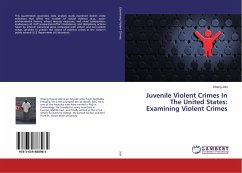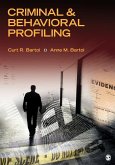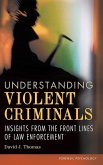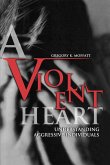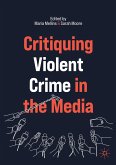- Gebundenes Buch
- Merkliste
- Auf die Merkliste
- Bewerten Bewerten
- Teilen
- Produkt teilen
- Produkterinnerung
- Produkterinnerung
As in previous editions, this book is appropriate for criminal investigation, forensic psychology, criminal behavior and interpersonal violence courses, generally as a supplement to a core text or as one of several paperbacks. The authors continuing research and involvement in field investigation are a source of relevant and often high profile case studies to illustrate theory and application of methods shown. Chapters include Arson, Pedophilia and Psychological Profiling and Rape. This edition features a new chapter on Lizzie Borden, analyzing this historic murder case with fresh insight and…mehr
Andere Kunden interessierten sich auch für
![Serious and Violent Juvenile Offenders Serious and Violent Juvenile Offenders]() Rolf Loeber / David P. Farrington (eds.)Serious and Violent Juvenile Offenders187,99 €
Rolf Loeber / David P. Farrington (eds.)Serious and Violent Juvenile Offenders187,99 €![Juvenile Violent Crimes In The United States: Examining Violent Crimes Juvenile Violent Crimes In The United States: Examining Violent Crimes]() Obang JobiJuvenile Violent Crimes In The United States: Examining Violent Crimes42,99 €
Obang JobiJuvenile Violent Crimes In The United States: Examining Violent Crimes42,99 €![INFLUENCE OF ECONOMIC HARDSHIP ON VIOLENT CRIMES INFLUENCE OF ECONOMIC HARDSHIP ON VIOLENT CRIMES]() Kiptum JamesINFLUENCE OF ECONOMIC HARDSHIP ON VIOLENT CRIMES36,99 €
Kiptum JamesINFLUENCE OF ECONOMIC HARDSHIP ON VIOLENT CRIMES36,99 €![Criminal & Behavioral Profiling Criminal & Behavioral Profiling]() Curtis R. BartolCriminal & Behavioral Profiling78,99 €
Curtis R. BartolCriminal & Behavioral Profiling78,99 €![Understanding Violent Criminals Understanding Violent Criminals]() David ThomasUnderstanding Violent Criminals69,99 €
David ThomasUnderstanding Violent Criminals69,99 €![A Violent Heart A Violent Heart]() Gregory K. MoffattA Violent Heart41,99 €
Gregory K. MoffattA Violent Heart41,99 €![Critiquing Violent Crime in the Media Critiquing Violent Crime in the Media]() Critiquing Violent Crime in the Media30,99 €
Critiquing Violent Crime in the Media30,99 €-
-
-
As in previous editions, this book is appropriate for criminal investigation, forensic psychology, criminal behavior and interpersonal violence courses, generally as a supplement to a core text or as one of several paperbacks. The authors continuing research and involvement in field investigation are a source of relevant and often high profile case studies to illustrate theory and application of methods shown. Chapters include Arson, Pedophilia and Psychological Profiling and Rape. This edition features a new chapter on Lizzie Borden, analyzing this historic murder case with fresh insight and a unique analysis. The text is particularly readable and engaging, making frequent use of illustrative tables, figures and occasional photos.
Hinweis: Dieser Artikel kann nur an eine deutsche Lieferadresse ausgeliefert werden.
Hinweis: Dieser Artikel kann nur an eine deutsche Lieferadresse ausgeliefert werden.
Produktdetails
- Produktdetails
- Verlag: Sage Publications
- 4. Auflage
- Seitenzahl: 340
- Erscheinungstermin: 1. Dezember 2008
- Englisch
- Abmessung: 235mm x 157mm x 23mm
- Gewicht: 644g
- ISBN-13: 9781412959971
- ISBN-10: 1412959977
- Artikelnr.: 25052173
- Herstellerkennzeichnung
- Libri GmbH
- Europaallee 1
- 36244 Bad Hersfeld
- gpsr@libri.de
- Verlag: Sage Publications
- 4. Auflage
- Seitenzahl: 340
- Erscheinungstermin: 1. Dezember 2008
- Englisch
- Abmessung: 235mm x 157mm x 23mm
- Gewicht: 644g
- ISBN-13: 9781412959971
- ISBN-10: 1412959977
- Artikelnr.: 25052173
- Herstellerkennzeichnung
- Libri GmbH
- Europaallee 1
- 36244 Bad Hersfeld
- gpsr@libri.de
Ronald M. Holmes is Coroner, in the Jefferson County Coroner¿s office and Professor Emeritus of Justice Administration at the University of Louisville. He is the author of several books, among them Profiling Violent Crimes, Sex Crimes, and Serial Murder. He is also the author of more than 50 articles appearing in scholarly publications. He is Vice President of the National Center for the Study of Unresolved Homicides and has completed more than 500 psychological profiles for police departments across the United States. He received his doctorate from Indiana University. is Coroner, in the Jefferson County Coroner¿s office and Professor Emeritus of Justice Administration at the University of Louisville. He is the author of several books, among them and He is also the author of more than 50 articles appearing in scholarly publications. He is Vice President of the National Center for the Study of Unresolved Homicides and has completed more than 500 psychological profiles for police departments across the United States. He received his doctorate from Indiana University.
Preface
1. Psychological Profiling: An Introduction
Inductive Versus Deductive Profiling
Goals in Profiling
Profiling: An Art, Not a Science
Conclusion
2. Profiling in Fantasy and Fact
Introduction
Sherlock Holmes: The Master Detective
Will Graham and The Red Dragon
Clarice Starling and The Silence of the Lambs
Zoe Koehler: A Female Serial Murderess
Alex Cross
Dr. Laszlo Kreizler: The Alienist and Angel of Darkness
Other Works of Fiction and Psychological Profiling
Profililng in Fact
Profile of a Rape Case
Case Profile: Mrs. Charlene L. Miller
Conclusion
3. The Rationale for Psychological Profiling
Personality and Crime
Biology
Culture
Environment
Common Experiences
Unique Experiences
New Ways of Viewing the Personality
Assumptions of the Profiling Process
Conclusion
4. Criminal Theories and Psychological Profiling
Theories of Crime and Criminality
Inidividual Theories of Crime
Social/Ecological Theories of Crime
Combining the Disciplines
5. The Analysis of the Crime Scene
Beyond the Physical Evidence
Psychological Profiling Typology
Crime Scene Differences
Conclusion
6. Arson and Psychological Profiling
What Is Arson?
Statistics on Arson
A View of the Firesetter
Typologies of Firesetters
Firesetting Experience
Organized Versus Disorganized Personality
Conclusion
7. Profiling Serial Murderers
Typology of Serial Murderers
Spatial Mobility of Serial Killers
Serial Murderers: General Characteristics
Profiling A Serial Murder Case
Conclusion
8. Psychological Profiling and Rape
Definitions of Rape
Statistics on Rape
Selected Characteristics of Rapists
Psychology and Rape
Typology of Rapists
Conclusion
9. Pedophilia and Psychological Profiling
Definition of Terms: Child Molester or Pedophile
Types of Pedophiles
Profiling Child Molester Types
Common Threads Among Child Molesters
Conclusion
10. Autoeroticism
What Is Autoerotic Sexual Behavior?
Traits and Characteristics fo Autoeroticism Practitioners
Autoerotic Scene Indicators
Conclusion
11. Profiling Satanic and Cult-Related Murders
Roots of Satanism
Satanism in the United States
The Satanic Bible
Types of Personal Involvement in Satanism
General Beliefs in Satansim
Satanic Masses
Satanic Ceremonies
Crime Scene Elements
Santeria and Occult Crimes
Conclusion
12. Geography, Profiling and Predatory Criminals
The Elements of Geographic Profiling
The Nature of Geographic Profiling
Computerized Geographic Analysis
Conclusion
13. Jack the Ripper
Introduction
Victim: Mary Ann "Polly" Nichols
Victim: Annie Chapman
Victim: Elizabeth Stride
Victim: Catharine Eddowes
Victim: Mary Kelly
Who Was Jack the Ripper?
Conclusion
14. Lizzie Borden
Key People in the Lizzie Borden Case
The Murders
The Crime Scene
Additional Thoughts
Conclusion
15. The Victim in Criminal Profiling
Elements in the Victim Profiling Process
Conclusion
16. The Future of Criminal Profiling
Additional Uses for Profiling
Education and Training for Profiling
Computerized Monitoring
Computerized Profiling
Online Graduate Programs, Seminars, and Degrees
Conclusion
1. Psychological Profiling: An Introduction
Inductive Versus Deductive Profiling
Goals in Profiling
Profiling: An Art, Not a Science
Conclusion
2. Profiling in Fantasy and Fact
Introduction
Sherlock Holmes: The Master Detective
Will Graham and The Red Dragon
Clarice Starling and The Silence of the Lambs
Zoe Koehler: A Female Serial Murderess
Alex Cross
Dr. Laszlo Kreizler: The Alienist and Angel of Darkness
Other Works of Fiction and Psychological Profiling
Profililng in Fact
Profile of a Rape Case
Case Profile: Mrs. Charlene L. Miller
Conclusion
3. The Rationale for Psychological Profiling
Personality and Crime
Biology
Culture
Environment
Common Experiences
Unique Experiences
New Ways of Viewing the Personality
Assumptions of the Profiling Process
Conclusion
4. Criminal Theories and Psychological Profiling
Theories of Crime and Criminality
Inidividual Theories of Crime
Social/Ecological Theories of Crime
Combining the Disciplines
5. The Analysis of the Crime Scene
Beyond the Physical Evidence
Psychological Profiling Typology
Crime Scene Differences
Conclusion
6. Arson and Psychological Profiling
What Is Arson?
Statistics on Arson
A View of the Firesetter
Typologies of Firesetters
Firesetting Experience
Organized Versus Disorganized Personality
Conclusion
7. Profiling Serial Murderers
Typology of Serial Murderers
Spatial Mobility of Serial Killers
Serial Murderers: General Characteristics
Profiling A Serial Murder Case
Conclusion
8. Psychological Profiling and Rape
Definitions of Rape
Statistics on Rape
Selected Characteristics of Rapists
Psychology and Rape
Typology of Rapists
Conclusion
9. Pedophilia and Psychological Profiling
Definition of Terms: Child Molester or Pedophile
Types of Pedophiles
Profiling Child Molester Types
Common Threads Among Child Molesters
Conclusion
10. Autoeroticism
What Is Autoerotic Sexual Behavior?
Traits and Characteristics fo Autoeroticism Practitioners
Autoerotic Scene Indicators
Conclusion
11. Profiling Satanic and Cult-Related Murders
Roots of Satanism
Satanism in the United States
The Satanic Bible
Types of Personal Involvement in Satanism
General Beliefs in Satansim
Satanic Masses
Satanic Ceremonies
Crime Scene Elements
Santeria and Occult Crimes
Conclusion
12. Geography, Profiling and Predatory Criminals
The Elements of Geographic Profiling
The Nature of Geographic Profiling
Computerized Geographic Analysis
Conclusion
13. Jack the Ripper
Introduction
Victim: Mary Ann "Polly" Nichols
Victim: Annie Chapman
Victim: Elizabeth Stride
Victim: Catharine Eddowes
Victim: Mary Kelly
Who Was Jack the Ripper?
Conclusion
14. Lizzie Borden
Key People in the Lizzie Borden Case
The Murders
The Crime Scene
Additional Thoughts
Conclusion
15. The Victim in Criminal Profiling
Elements in the Victim Profiling Process
Conclusion
16. The Future of Criminal Profiling
Additional Uses for Profiling
Education and Training for Profiling
Computerized Monitoring
Computerized Profiling
Online Graduate Programs, Seminars, and Degrees
Conclusion
Preface
1. Psychological Profiling: An Introduction
Inductive Versus Deductive Profiling
Goals in Profiling
Profiling: An Art, Not a Science
Conclusion
2. Profiling in Fantasy and Fact
Introduction
Sherlock Holmes: The Master Detective
Will Graham and The Red Dragon
Clarice Starling and The Silence of the Lambs
Zoe Koehler: A Female Serial Murderess
Alex Cross
Dr. Laszlo Kreizler: The Alienist and Angel of Darkness
Other Works of Fiction and Psychological Profiling
Profililng in Fact
Profile of a Rape Case
Case Profile: Mrs. Charlene L. Miller
Conclusion
3. The Rationale for Psychological Profiling
Personality and Crime
Biology
Culture
Environment
Common Experiences
Unique Experiences
New Ways of Viewing the Personality
Assumptions of the Profiling Process
Conclusion
4. Criminal Theories and Psychological Profiling
Theories of Crime and Criminality
Inidividual Theories of Crime
Social/Ecological Theories of Crime
Combining the Disciplines
5. The Analysis of the Crime Scene
Beyond the Physical Evidence
Psychological Profiling Typology
Crime Scene Differences
Conclusion
6. Arson and Psychological Profiling
What Is Arson?
Statistics on Arson
A View of the Firesetter
Typologies of Firesetters
Firesetting Experience
Organized Versus Disorganized Personality
Conclusion
7. Profiling Serial Murderers
Typology of Serial Murderers
Spatial Mobility of Serial Killers
Serial Murderers: General Characteristics
Profiling A Serial Murder Case
Conclusion
8. Psychological Profiling and Rape
Definitions of Rape
Statistics on Rape
Selected Characteristics of Rapists
Psychology and Rape
Typology of Rapists
Conclusion
9. Pedophilia and Psychological Profiling
Definition of Terms: Child Molester or Pedophile
Types of Pedophiles
Profiling Child Molester Types
Common Threads Among Child Molesters
Conclusion
10. Autoeroticism
What Is Autoerotic Sexual Behavior?
Traits and Characteristics fo Autoeroticism Practitioners
Autoerotic Scene Indicators
Conclusion
11. Profiling Satanic and Cult-Related Murders
Roots of Satanism
Satanism in the United States
The Satanic Bible
Types of Personal Involvement in Satanism
General Beliefs in Satansim
Satanic Masses
Satanic Ceremonies
Crime Scene Elements
Santeria and Occult Crimes
Conclusion
12. Geography, Profiling and Predatory Criminals
The Elements of Geographic Profiling
The Nature of Geographic Profiling
Computerized Geographic Analysis
Conclusion
13. Jack the Ripper
Introduction
Victim: Mary Ann "Polly" Nichols
Victim: Annie Chapman
Victim: Elizabeth Stride
Victim: Catharine Eddowes
Victim: Mary Kelly
Who Was Jack the Ripper?
Conclusion
14. Lizzie Borden
Key People in the Lizzie Borden Case
The Murders
The Crime Scene
Additional Thoughts
Conclusion
15. The Victim in Criminal Profiling
Elements in the Victim Profiling Process
Conclusion
16. The Future of Criminal Profiling
Additional Uses for Profiling
Education and Training for Profiling
Computerized Monitoring
Computerized Profiling
Online Graduate Programs, Seminars, and Degrees
Conclusion
1. Psychological Profiling: An Introduction
Inductive Versus Deductive Profiling
Goals in Profiling
Profiling: An Art, Not a Science
Conclusion
2. Profiling in Fantasy and Fact
Introduction
Sherlock Holmes: The Master Detective
Will Graham and The Red Dragon
Clarice Starling and The Silence of the Lambs
Zoe Koehler: A Female Serial Murderess
Alex Cross
Dr. Laszlo Kreizler: The Alienist and Angel of Darkness
Other Works of Fiction and Psychological Profiling
Profililng in Fact
Profile of a Rape Case
Case Profile: Mrs. Charlene L. Miller
Conclusion
3. The Rationale for Psychological Profiling
Personality and Crime
Biology
Culture
Environment
Common Experiences
Unique Experiences
New Ways of Viewing the Personality
Assumptions of the Profiling Process
Conclusion
4. Criminal Theories and Psychological Profiling
Theories of Crime and Criminality
Inidividual Theories of Crime
Social/Ecological Theories of Crime
Combining the Disciplines
5. The Analysis of the Crime Scene
Beyond the Physical Evidence
Psychological Profiling Typology
Crime Scene Differences
Conclusion
6. Arson and Psychological Profiling
What Is Arson?
Statistics on Arson
A View of the Firesetter
Typologies of Firesetters
Firesetting Experience
Organized Versus Disorganized Personality
Conclusion
7. Profiling Serial Murderers
Typology of Serial Murderers
Spatial Mobility of Serial Killers
Serial Murderers: General Characteristics
Profiling A Serial Murder Case
Conclusion
8. Psychological Profiling and Rape
Definitions of Rape
Statistics on Rape
Selected Characteristics of Rapists
Psychology and Rape
Typology of Rapists
Conclusion
9. Pedophilia and Psychological Profiling
Definition of Terms: Child Molester or Pedophile
Types of Pedophiles
Profiling Child Molester Types
Common Threads Among Child Molesters
Conclusion
10. Autoeroticism
What Is Autoerotic Sexual Behavior?
Traits and Characteristics fo Autoeroticism Practitioners
Autoerotic Scene Indicators
Conclusion
11. Profiling Satanic and Cult-Related Murders
Roots of Satanism
Satanism in the United States
The Satanic Bible
Types of Personal Involvement in Satanism
General Beliefs in Satansim
Satanic Masses
Satanic Ceremonies
Crime Scene Elements
Santeria and Occult Crimes
Conclusion
12. Geography, Profiling and Predatory Criminals
The Elements of Geographic Profiling
The Nature of Geographic Profiling
Computerized Geographic Analysis
Conclusion
13. Jack the Ripper
Introduction
Victim: Mary Ann "Polly" Nichols
Victim: Annie Chapman
Victim: Elizabeth Stride
Victim: Catharine Eddowes
Victim: Mary Kelly
Who Was Jack the Ripper?
Conclusion
14. Lizzie Borden
Key People in the Lizzie Borden Case
The Murders
The Crime Scene
Additional Thoughts
Conclusion
15. The Victim in Criminal Profiling
Elements in the Victim Profiling Process
Conclusion
16. The Future of Criminal Profiling
Additional Uses for Profiling
Education and Training for Profiling
Computerized Monitoring
Computerized Profiling
Online Graduate Programs, Seminars, and Degrees
Conclusion

